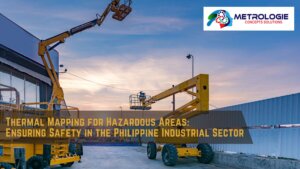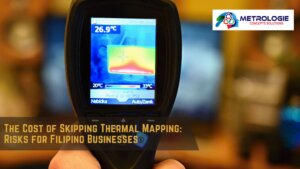Thermal mapping, or thermography, is a powerful non-destructive testing technique that utilizes infrared cameras to visualize and measure temperature variations across surfaces. This technology has become indispensable in diverse industries, from building inspections and electrical maintenance to medical diagnostics and industrial process monitoring. However, the accuracy and reliability of thermal mapping data hinge on a thorough understanding of its underlying science and the key metrics involved. This comprehensive guide delves into the science of thermal mapping, exploring the crucial metrics and their importance in obtaining meaningful and actionable insights.
Understanding the Fundamentals of Thermal Mapping:
Thermal mapping is based on the principle that all objects emit infrared radiation, a form of electromagnetic radiation invisible to the human eye. The intensity of this radiation is directly proportional to the object’s temperature. Infrared cameras detect and measure this radiation, converting it into a visual representation of temperature distribution, known as a thermogram.
Key Metrics in Thermal Mapping:
- Emissivity (ε):
- Definition: Emissivity is a measure of a surface’s ability to emit infrared radiation compared to a perfect blackbody (a theoretical object that absorbs and emits all radiation).
- Importance: Emissivity significantly affects the accuracy of temperature measurements. Different materials have different emissivities, and failing to account for this can lead to substantial errors.
- Factors Affecting Emissivity: Material type, surface finish, temperature, and viewing angle.
- Practical Applications: In building inspections, understanding the emissivity of different building materials is crucial for accurately identifying insulation deficiencies. In electrical maintenance, emissivity correction helps pinpoint hot spots in electrical components.
- Temperature Resolution (NETD):
- Definition: Noise Equivalent Temperature Difference (NETD) represents the smallest temperature difference that a thermal imaging camera can detect.
- Importance: A lower NETD indicates higher sensitivity and the ability to detect subtle temperature variations. This is critical for applications where minute temperature differences are significant.
- Measurement Unit: Millikelvins (mK).
- Practical Applications: In medical diagnostics, a high-resolution camera with a low NETD can detect subtle temperature changes associated with inflammation or other medical conditions. In industrial process monitoring, it can help identify minor temperature variations that may indicate process inefficiencies.
- Thermal Sensitivity:
- Definition: Thermal sensitivity refers to the camera’s ability to respond to small changes in temperature. It is closely related to NETD.
- Importance: High thermal sensitivity ensures that the camera can capture accurate temperature readings even in environments with minimal temperature differences.
- Practical Applications: In building inspections, high thermal sensitivity helps detect subtle air leaks or insulation deficiencies. In electrical inspections, it helps identify minor overheating issues that may indicate potential failures.
- Spatial Resolution (IFOV):
- Definition: Instantaneous Field of View (IFOV) refers to the smallest area that the camera can measure at a specific distance.
- Importance: Higher spatial resolution allows for more detailed and accurate temperature measurements of small objects or fine details.
- Measurement Unit: Milliradians (mrad).
- Practical Applications: In electrical inspections, high spatial resolution helps identify the precise location of hot spots on small components. In building inspections, it helps pinpoint the exact location of air leaks or moisture intrusion.
- Temperature Range:
- Definition: Temperature range refers to the range of temperatures that the thermal imaging camera can measure.
- Importance: Selecting a camera with an appropriate temperature range is crucial for the specific application. For example, high-temperature applications like furnace inspections require cameras with extended temperature ranges.
- Practical Applications: In industrial process monitoring, cameras with wide temperature ranges are needed to monitor high-temperature processes like metal casting or glass manufacturing. In building inspections, a moderate temperature range is sufficient for detecting insulation deficiencies or air leaks.
- Spectral Range:
- Definition: Spectral range refers to the range of infrared wavelengths that the camera can detect.
- Importance: Different materials emit infrared radiation at different wavelengths. Selecting a camera with an appropriate spectral range is crucial for specific applications.
- Practical Applications: In gas leak detection, cameras with specific spectral ranges are used to detect the infrared signatures of different gases. In high-temperature applications, cameras with shorter spectral ranges are often used to minimize atmospheric absorption.
- Accuracy and Precision:
- Definition: Accuracy refers to the closeness of a measurement to the true value, while precision refers to the repeatability of measurements. 1 1. ru.scribd.com ru.scribd.com
- Importance: High accuracy and precision are essential for reliable thermal mapping data. Calibration and proper measurement techniques are crucial for achieving accurate and precise results.
- Practical Applications: In medical diagnostics, accurate temperature measurements are essential for diagnosing medical conditions. In industrial process monitoring, precise temperature measurements are needed to maintain consistent product quality.
- Frame Rate:
- Definition: Frame rate refers to the number of thermograms captured per second.
- Importance: A higher frame rate allows for capturing dynamic temperature changes and analyzing moving objects.
- Measurement Unit: Hertz (Hz).
- Practical Applications: In mechanical inspections, a high frame rate helps capture rapid temperature changes associated with rotating machinery. In research and development, it helps analyze dynamic thermal processes.
Factors Affecting Thermal Mapping Results:
- Ambient Temperature: The temperature of the surrounding environment can affect the accuracy of thermal measurements.
- Reflected Radiation: Surfaces can reflect infrared radiation from other objects, leading to inaccurate readings.
- Atmospheric Absorption: Water vapor and other gases in the atmosphere can absorb infrared radiation, affecting measurements.
- Distance and Angle: The distance and angle between the camera and the target surface can affect the accuracy of measurements.
Best Practices for Accurate Thermal Mapping:
- Proper Camera Calibration: Regularly calibrate the thermal imaging camera to ensure accuracy.
- Emissivity Correction: Apply emissivity correction based on the material being inspected.
- Ambient Temperature Compensation: Account for ambient temperature when analyzing thermal data.
- Minimize Reflected Radiation: Use reflective shields or adjust the viewing angle to minimize reflected radiation.
- Consider Atmospheric Absorption: Account for atmospheric absorption, especially when measuring over long distances.
- Use Appropriate Measurement Techniques: Follow established measurement techniques and procedures.
- Thorough Documentation: Document all measurement parameters and environmental conditions.
- Certified Thermographers: Ensure that thermal mapping is performed by certified thermographers who have the expertise to interpret thermal data.
The Future of Thermal Mapping:
Advancements in sensor technology, data analysis, and artificial intelligence are continuously improving the capabilities of thermal mapping. Future developments will likely include:
- Higher Resolution Sensors: Enabling more detailed and accurate thermal imaging.
- Advanced Image Processing: Improving image quality and data analysis.
- AI-Powered Analysis: Automating data interpretation and anomaly detection.
- Hyperspectral Imaging: Expanding the spectral range for more detailed material analysis.
- Integration with IoT: Enabling real-time monitoring and predictive maintenance.
Key Takeaways:
- Thermal mapping is a powerful tool for visualizing and measuring temperature variations.
- Understanding key metrics like emissivity, temperature resolution, and spatial resolution is crucial for accurate data analysis.
- Ambient temperature, reflected radiation, and atmospheric absorption can affect thermal mapping results.
- Proper camera calibration, emissivity correction, and ambient temperature compensation are essential for reliable data.
- Advancements in technology are continuously improving the capabilities of thermal mapping.
By understanding the science of thermal mapping and applying best practices, professionals can unlock the full potential of this technology and gain valuable insights into the thermal behavior of various objects and systems.




